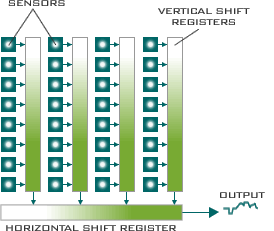Until recently the industrial digital vision sensor
market was dominated by the CCD array. However technological advances in CMOS
production techniques have led to a gradual increase in the popularity of this
sensor type. Like CCD arrays, CMOS sensors are also formed on a silicon
substrate but the structure is more akin to that of other CMOS technology such
as RAM and ROM memory devices.
The diagram below is that of an actual CMOS sensor
showing the active pixel area in green and the area occupied by the on chip
circuitry in yellow, which replaces that of the shuttered area on a CCD based
sensor. The on chip circuitry actually converts the charge into voltage on each
pixel whereas the CCD sensor shifts the charge vertically row by row, and then
horizontally pixel by pixel to be converted to voltage when it reaches one or
more output nodes. This gives CMOS sensors an advantage when it comes to
windowing or a region of interest as the pixels can be read out randomly. CCD
sensors can only limit its region of interest vertically with the resulting
image always containing the data for the full image width.
The on chip active amplifier and the sampling capacitor
give CMOS sensors advantages in terms of speed, full well capacities and much
improved response characteristics yet introduce dark current level noise and
higher black pixel content. CMOS sensors can also produce higher levels of
fixed pattern noise than that of CCD, but this type of noise can be easily
removed with a software filter.
The development of CMOS sensor technology has been a
rapid and varied process. The initial aim of CMOS sensors was to match the
imaging performance of CCD technology, with lower power requirements and at
less cost. To achieve this performance it was discovered that a much greater
level of manufacturing process adaptation and deeper submicron lithography were
required than initially expected. This led to the desired CMOS performance but
increased development costs more than anticipated.
At first the low power feature of the CMOS imaging
sensors was set to be one of their distinct advantages, however the improved
development of CCD sensors means that while CMOS has the advantage in this
area, the margin is now much smaller.
The integration of on chip control circuitry with the
CMOS imager provides the sensor with greater flexibility and integration, the
downside has been the introduction of greater noise levels. Both CMOS and CCD
imaging sensors still require support chips to process the image, however CMOS
imagers can be produced with more functionality on the sensor chip, as shown
below.
The spectral response of a CMOS sensor differs from that
of the CCD sensors in that the peak response is sited at around 700Nm. Both
sensors operate over the same range, typically 200Nm to 1100Nm.
The main advantages of CMOS imaging sensors still remain
as faster response, increased integration flexibility and lower on-chip power
demands. However the image quality has yet to match that of the CCD and the
supporting chips required to increase the CMOS image quality goes some way to
squander its previous advantages. Yet neither sensor is categorically superior
to the other. They both have their own advantages and disadvantages and with
CMOS developers working on the image quality, and CCD developers aiming to
reduce power demands and increase flexibility, the existing margins in place to
decide which sensor is most suitable for an application look to narrow further.










